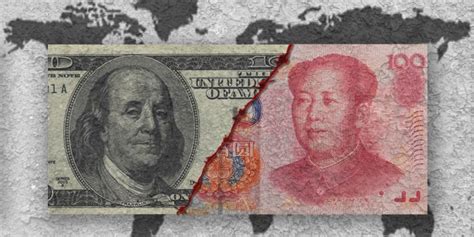Introduction
The global economic landscape is undergoing a seismic shift, with the rise of China and the potential decline of the United States. As these two superpowers vie for economic dominance, the value of their currencies is becoming increasingly critical. In this article, we will delve into the evolving relationship between the Chinese yuan (CNY) and the US dollar (USD) and explore the implications for global trade, investment, and economic growth.

The Yuan’s Ascendance
For decades, the USD has reigned supreme as the world’s reserve currency, but the yuan is rapidly gaining ground. In 2021, the yuan accounted for 2.7% of global foreign exchange reserves, up from just 0.5% in 2010. This surge is driven by China’s economic growth, the internationalization of the yuan, and the declining confidence in the USD.
The Dollar’s Resilience
Despite the yuan’s rise, the USD remains the dominant currency in international trade and investment. In 2021, over 59% of global payments were made in USD, and it accounts for nearly 62% of global foreign exchange reserves. The USD’s strength stems from its historical stability, its role as the currency of choice for international transactions, and the global dominance of US assets.
Factors Shaping the Yuan-Dollar Relationship
The relationship between the yuan and the dollar is influenced by a complex interplay of factors, including:
- Economic growth: China’s rapid economic growth is a major driver of yuan appreciation. As China’s economy continues to expand, demand for the yuan is expected to rise.
- Trade flows: China’s massive trade surplus with the US creates a constant flow of dollars into China, which helps support the yuan’s value.
- Interest rate differentials: When interest rates in China are higher than in the US, this attracts foreign investment and supports the yuan’s value.
- Geopolitical tensions: Trade disputes, military confrontations, and political tensions between the US and China can impact the value of their currencies.
Implications for the Global Economy
The evolving yuan-dollar relationship has significant implications for the global economy:
- Trade imbalances: The appreciation of the yuan could reduce China’s trade surplus with the US, potentially mitigating global trade imbalances.
- Investment flows: Greater currency diversification among central banks and investors could lead to more balanced capital flows and reduce financial risks.
- Global growth: The emergence of the yuan as a global currency could stimulate global economic growth by expanding trade and investment opportunities.
Future Trends and Outlook
The future of the yuan-dollar relationship is uncertain, but several trends point to the continued rise of the yuan:
- China’s economic growth: China is projected to remain a major economic powerhouse, which will continue to support the yuan’s appreciation.
- Internationalization of the yuan: The Chinese government is actively promoting the international use of the yuan, which will increase its role in global trade and investment.
- Reduced reliance on the USD: Central banks around the world are diversifying their foreign exchange reserves away from the USD, which will weaken its dominance over time.
Tips and Tricks for Businesses
Businesses can navigate the evolving yuan-dollar relationship by:
- Monitoring currency trends: Stay informed about the latest developments in the yuan-dollar exchange rate and consider hedging against currency risks.
- Diversifying investments: Spread investments across different currencies to mitigate the impact of fluctuations in any one currency.
- Expanding into new markets: Consider entering new markets that use the yuan as a way to reduce exposure to USD fluctuations.
Conclusion
The yuan-dollar relationship is a dynamic and evolving one, with profound implications for the global economy. As the yuan continues to rise, it is likely to challenge the dominance of the USD and reshape the international monetary system. Businesses and investors need to stay abreast of these trends and adjust their strategies accordingly to capitalize on the opportunities and mitigate the risks presented by the changing currency landscape.


